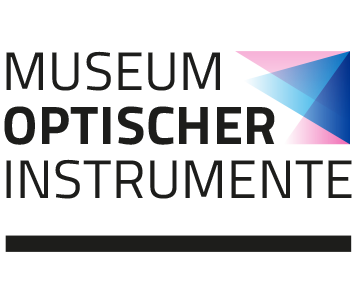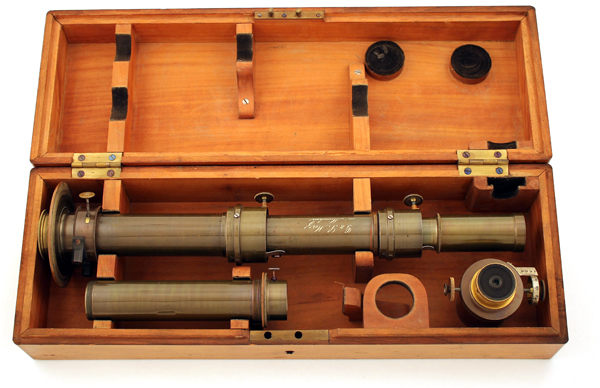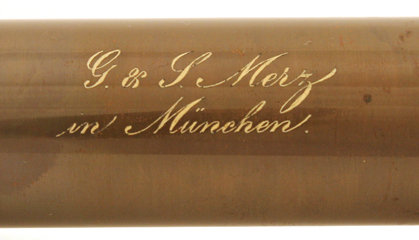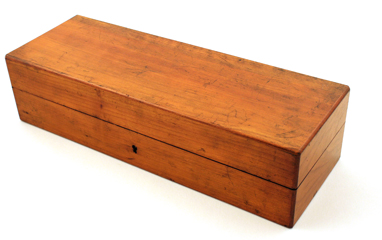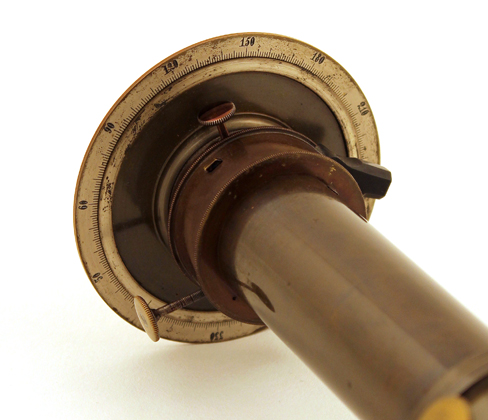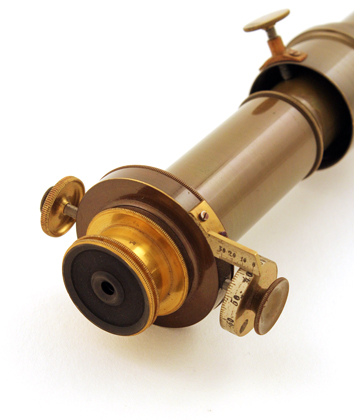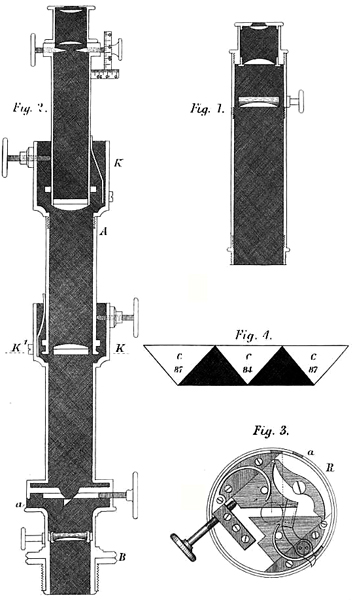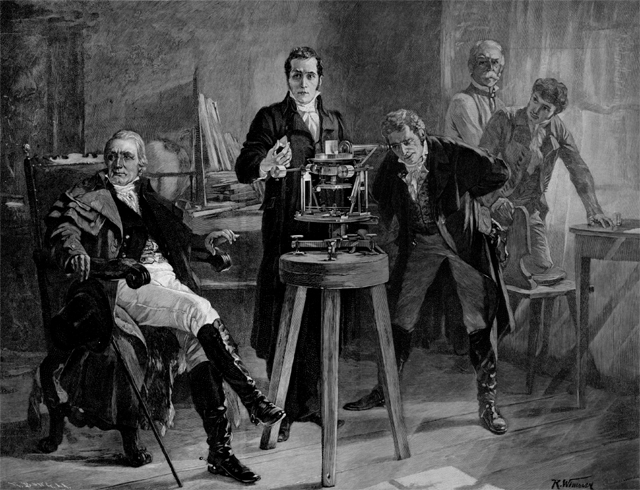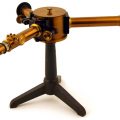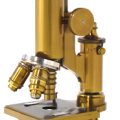Universal-Sternspektroskop
G. & S. Merz in München
Universal-Sternspektroskop von Merz, um 1870.
Das Instrument ist gefertigt aus dunkel gebeiztem und klar lackiertem Messing. Das Instrument verfügt über zwei Geradsichtspektroskopen, die untereinander zu einem Spektroskop größerer Brechkraft kombiniert werden können. Das Instrument ist zur Verwendung an mittelgroßen Refraktoren vorgesehen, um die Beobachtungsposition zu bestimmen kann an einer Scheibe in Inkrementen zu 1° über den vollen Kreis die Rotation abgelesen werden. Die Beobachtungsspalte sind variabel, seitlich ist zudem eine Vorrichtung angebracht, um ein Vergleichsspektrum einspiegeln zu können. Die Positionen der Spektrallinien lassen sich mit einem feinen Spitzenmikrometer ablesen.
In der Kirschholzkasette liegend wird das Instrument zerlegt untergebracht.
Den zeitgenössischen Beschreibungen nach zu urteilen fehlt der Originalausstattung des Instruments im Wesentlichen nur ein Sonnenglas um als Protuberanzenspektroskop verwendet zu werden sowie das zweite der beiden Okulare.
Auf dem das Geradsichtprisma enthaltenen Rohr ist das Gerät dekorativ in weiß hinterlegter Schrift signiert:
G. & S. Merz
in München
Das hier gezeigte Sternspektroskop
wird in der ersten Version 1870 vorgestellt (S. Merz: Kleines Universal-Stern-Spectroscop. Ph. Carl [Hrsg.]: Repertorium für Experimental-Physik, für physikalische Technik, mathematische & astronomische Instrumentenkunde VI, 1870: 273):
Kleines Universal – Stern – Spectroscop.
Von Sigmund Merz.
(Hierzu Tafel XVI, Fig. 5 und 6.)
Dasselbe besteht aus einem einfachen und einem zusammengesetzten Spectroscop à vision directe, die sich theilweise ergänzen. Ersterer Apparat besitzt ein Prisma à vision directe von einer Zerstreuungskraft D-H = 8° und ein positives Ocular von l“ aequiv. Brennweite nebst Cylinderlinse. Der zusammengesetzte Apparat hat ein gleiches Spectral-Prisma, Spalte, Collimator und Beobachtungsfernrohr. Die Objective der letzteren sind von gleicher Focalweite und haben bei 4“ Focus 7″‚ Oeffnung. Das Beobachtungsfemrohr ist mit Spitzenmicrometer versehen, besitzt ein positives Ocular von 1″ und ist mit den nöthigen feinen Einstellungen ausgestattet.
mehr anzeigen
Die Spalte hat die nöthigen Correctionen, hinter sich ein Reflexions-Prisma zur Flammenvergleichung und eine cylindrische Collectivlinse. Noch ist dieser zusammengesetzte Apparat mit einer kleinen Positions-Scheibe versehen. Von dem einfachen Apparate nun kann das Spectral-Prisma abgeschraubt und zwischen Collimator und Spectral-Prisma des zusammengesetzten Apparates eingesezt werden, wodurch die Dispersion des Spectroscopes verdoppelt und das Instrumentchen auch zur Beobachtung der Sonnenprotuberanzen tauglich wird. Die Spalte hat zu dem Zwecke auch die Einrichtung, dass sie entsprechend weit geöffnet werden kann. Dem Apparat ist überdies ein Sonnenglas beigegeben und sämmtliche Theile in einem eleganten Etui befindlich. Preis 120 Thlr. = 210 fl.
weniger anzeigen
Leicht modifiziert veröffentlicht Merz eine kleine Abhandlung auf englisch dazu
(S. Merz: On a small universal stellar spectroscope. Philosophlical Magazine, S 4, 41 (271) Feb. 1871: 129-132), das verbesserte Instrument kostet 30 bayrische Gulden mehr:
On a small Universal Stellar Spectroscope.
By M. Sigmund Merz.
[With a Plate.]
To Dr. Francis. F.L.S. &c.
Munich, November, 1870
Sir,
In Carl’s Repertorium der Physik, vol. vi. p. 273, there is contained the description of a small universal star-spectroscope constructed by me, accompanied by an explanatory Plate. As, however, since that article appeared this compendious little instrument has been improved in various essential particulars, at the suggestion of a friend I make bold to forward to you a short description thereof, and also a corrected sketch of its arrangement. The instrument consists of two principal parts, or, in other words, of two spectroscopes, each of which may be used singly, and which are in part complementary to each other. The one part, which is a simple direct-vision spectroscope, is provided with a prism of novel construction. This prism consists of five elements, two of which are of flint glass, each having a refracting-angle of 84°; the other three prisms are of crown glass; one of them has also a refracting-angle of 84°, the other two of 87°, as shown in Plate II.fig. 4. This portion of the apparatus is furnished with a positive eyepiece with an equivalent focal length of 1 inch, and it is also provided with a cylindrical lens of 1 inch radius. The arrangement of this portion of the apparatus is shown in fig. 1.
The compound spectroscope, which is represented in fig. 2, is provided with a similar spectral prism. It has a tube furnished with a slit, and a collimator, and likewise an observing-telescope. The object-glasses of the latter and of the collimator are of the same focal length, namely 4 inches; their aperture is 2/3 of an inch.
The observing telescope carries, moreover, a needle-micrometer with an eyepiece of 1/2-inch focal length. It is also provided with two red sun-glasses, which admit of being used either singly or together. This compound spectroscope is moreover furnished with a small divided position-circle situated at B.
The spectral prism can be unscrewed from the simple apparatus (fig. 1) and inserted at A, between the observing -telescope and the spectral prism of the compound apparatus (fig. 2), whereby the dispersion of the spectroscope is doubled, and the entire instrument rendered available for the observation of the solar protuberances.
mehr anzeigen
With the view of such observations, a peculiar construction has been given to the slit (fig. 3), by means of which, through the medium of a screw, its two steel jaws can be simultaneously moved away from the center and opened to the distance of nearly a quarter of an inch. The slit is further fitted with an arrangement for throwing aside the illuminating prism that is employed in comparing the spectra of flames. This latter movement is effected by means of a small lever, to the long arm of which the prism in question is attached, and the short arm of which is inserted into an aperture in the rotating ring R. When such a motion has been given to this ring that the aperture at which the light enters (a) is closed, the prism no longer remains opposite the slit, so that the cone of rays derived from the refractor has then free passage through the full width of the jaws.
The lateral movement near K on the observing-telescope enables any separate colour of the spectrum to be brought into position, while a similar movement at K‘ near the slit serves for altering the angle on incidence of the rays, thus bringing into the field of view the extreme portions of the spectrum, even when extended by the employment of the two systems of prisms.
With respect to the rectification of the instrument, it is only necessary to observe that all the parts that unscrew are provided with suitable marks; and, speaking generally, the apparatus may be looked upon as an adjustment when the so-called Fraunhofer lines are situated at right angles to the spectrum.
Universal-Spektroskop G. & S. Merz in München
The cylindrical lens, it should be remarked, is to be employed only in stellar observations; in other cases it should be removed. It admits off being turned round in position 90°, and can thus be placed either normal or parallel to the slit. If, for instance, the cylindrical lens is situated within the focus of the refractor and with its axis normal to the direction of the slit, it will elongate the little circular disk of the star parallel to the slit, or, in other words, it will form a luminous line coinciding with the direction of the slit, whereas in the opposite case the caustic if the cylindrical lens will lie crosswise to the slit. It should therefore be placed normal to the slit when observing in converging light, or when placed in the within the focus of the refractor; while, on the contrary, it has to be set parallel to the slite when observing beyond the focus, or in diverging light, in which case the caustic of the cylindrical lens coincides with the slit as before. And since the rotation of the cylindrical lens causes a change of direction of its caustic to the amount of 90°, this motion admits of the apparatus being always brought into the proper position, whether the cylindrical lens be in the converging or on the diverging cone of rays of the refractor.
Bearing in mind that the little observing-telescope and the collimator are of equal focal length, it is easy to calculate the spectroscopic amplification of the refractor employed. The amplification is equal to twice that of the focal length of the refractor, expressed in French inches, when the half-inch eyepiece is used, and is equal to the simple focal length when, instead of the half-inch, the 1-inch eyepiece is employed. Were the focal length of the observing-telescope and of the collimator not equal, the amplification would increase as the focal length of the collimator diminished, and vice versâ.
With reference to the efficiency of the instrument were described, I beg leave, in conclusion, to quote the following passage, translated from the letter addressed to me by Dr. Schellen of Cologne, on the 27th of September last. The writer therein says, „after duly adjusting your refractor of 34 lines aperture, in the possession of Herr von Camphausen, I was not only enabled to see at once brightly and with great distinctness the lines H alpha, H beta, and D 3, but also, on widening the aperture of the slit, to observe at different places on the sun’s limb various solar protuberances.“
The price of the complete apparatus, with the improvements above described, and packed in an elegant case, in 240 Bavarian florins, which are equal to GBP 20.
I am, Sir,
Yours respectfully
SIGMUND MERZ
weniger anzeigen
Bei diesem Spektroskop handelt es sich um ein Gerät,
welches von Angelo Secchi (1818-1878) in seiner Zeit als Leiter der Vatikansternwarte vorgeschlagen und von Merz vertrieben wird. Secchi wird 1850 Leiter der Sternwarte des Vatikans und verwendet für seine Studien einen Refraktor der Firma G. & S. Merz in München. Angespornt durch die Veröffentlichungen von Kirchhoff und Bunsen zur Spektralanalyse an Flammen und der damit verbundenen Erklärung der Fraunhofer-Linien des Sonnenspektrums beginnt Secchi mit der Charakterisierung von Sternspektren. 1867 veröffentlicht er den Catalogo Delle Stelle Di Cui Se Determinato Lo Spettro Luminoso All’osservatorio del Collegio Romano und beschreibt darin die Spektren von über 500 Fixsternen. Im Rahmen dieser Arbeit stellt er die erste Spektralklassifikation der Sterne vor. Hermann Carl Vogel greift diese Einteilung auf und veröffentlicht sie in modifizierter und erweiterter Form 1874, sie stellt die Basis der bis heute gültigen Harvard-Klassifikation dar.
Noch zu Beginn der 1920er Jahre wird dieser Typ des Spektroskops für mittelgroße Refraktoren verwendet. So heißt es in einem der damaligen Standardwerke (Hans Ludendorff [Hrsg.]: Newcomb-Engelmanns Populäre Astronomie. 6. Auflage, Engelmann Leipzig 1921: 231):
Fig. 96 stellt ein Sternspektroskop (von Merz in München nach Secchis Angaben geliefert) im Durchschnitt dar, wie es noch heutigen Tages mit einigen Modifikationen vielfach zur Beobachtung der Protuberanzen am Sonnenrande, insbesondere mit mittelgroßen Refraktoren, verwendet wird.
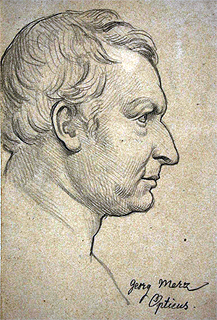 Über Georg Merz
Über Georg Merz
Der am 26. Januar 1793 in Bichl bei Benediktbeuren geborene Georg Merz besucht zunächst die Schule im benachbarten Stift und hilft seinem Vater, einem Leinweber, auf dem Felde in der Landwirtschaft. Als Utzschneider in Benediktbeuren eine Fabrik zur Herstellung von Flint- und Crownglas für sein optisches Institut errichtet, tritt Merz dort 1808 als Arbeiter ein. Angeregt von einem der Padres des mittlerweile säkularisierten Klosters studiert Merz in seiner freien Zeit mit großem Eifer Mathematik und Optik. Joseph von Fraunhofer erkennt die außerordentliche Begabung des jungen Arbeiters und ernennt ihn zum Werkführer.
Mit dem Tode Fraunhofers übernimmt Merz 1826 die Geschäftsleitung und wird zum Direktor der optischen Abteilung. Zusammen mit dem Mechaniker Franz Joseph Mahler wird er 1830 Teilhaber und 1839 Eigentümer des Instituts. Nach dem Tode Mahlers 1845 führt Georg Merz das Institut weiter unter Mitarbeit seiner Söhne Sigmund (1824 – 1908) und Ludwig (1817 – 1858). Das Institut wird nach München verlegt und die Signatur lautete „G. Merz & Söhne in München“.
Ludwig Merz stirbt 1858 mit 41 Jahren an Bleivergiftung, die er sich bei der Flintglasherstellung in Benediktbeuren zuzieht. Danach firmiert das Institut mit: „G. & S. Merz in München“.
Nun ist Sigmund alleiniger Inhaber des Institutes. Im Jahr 1871 hat das Unternehmen 63 Beschäftigte und signiert „G. & S. Merz (vormals Utzschneider & Fraunhofer) in München“. 1883 übergibt Sigmund Merz die Münchner Werkstätte an seinen langjährigen Gehilfen und Vetter Jakob Merz (1833 – 1906), dieser verkauft die traditionsreiche Firma am 5. Oktober 1903 an Paul Zschokke (1853 – 1932).
Da es unter Fraunhofers Federführung in Bediktbeuren und München gelungen ist, achromatische Linsenkombinationen zu erstellen, erlangt das Unternehmen rasch Weltrang. Das Wissen bleibt in der Firma und unter Merz führt sie noch bis Mitte des 19. Jahrhunderts im Bau großer Refraktoren für die Sternwarten Europas. Mikroskope sind, wie schon unter Fraunhofers Leitung, von eher untergeordneter Bedeutung und daher recht selten. Das optische Glas wird stets nur für den Bedarf der Werkstätte in der eigenen Glashütte geschmolzen und nicht als Rohstoff an andere Firmen verkauft.
Vergleiche ein etwas früheres Gerät:
National Observatory of Athens: „Astronomical Spectroscope“, The Hellenic Achrives of Scientific Instruments Inv.No. AST08
